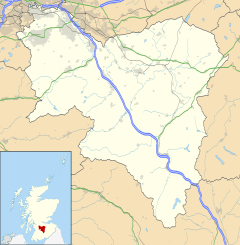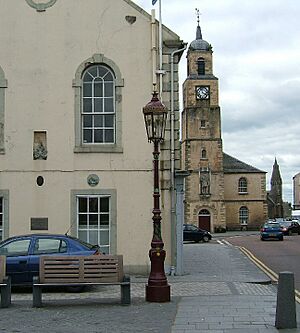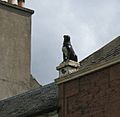Lanark facts for kids
Quick facts for kids Lanark
|
|
|---|---|
 Lanark High Street, August 2006 |
|
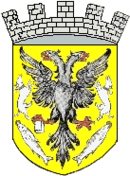 Coat of Arms of the Royal Burgh of Lanark |
|
| Population | 8,880 (2020) |
| OS grid reference | NS8843 |
| • Edinburgh | 29+1⁄2 miles (47.5 km) |
| • London | 325 miles (523 km) |
| Council area | |
| Lieutenancy area | |
| Country | Scotland |
| Sovereign state | United Kingdom |
| Post town | LANARK |
| Postcode district | ML11 |
| Dialling code | 01555 |
| Police | Strathclyde |
| Fire | Strathclyde |
| Ambulance | Scottish |
| EU Parliament | Scotland |
| UK Parliament | |
| Scottish Parliament | |
Lanark is a historic town in South Lanarkshire, Scotland. It is about 20 kilometres (12 miles) south-east of Hamilton. The town is located near the River Clyde, where it meets the Mouse Water. In 2016, about 9,050 people lived in Lanark.
Lanark was a special type of town called a royal burgh from 1140 to 1975. This meant it had special trading rights from the king. It was also the main town of Lanarkshire for a long time. Today, the nearby town of New Lanark is a famous World Heritage Site. Other important places nearby include the beautiful Corra Linn waterfalls.
Lanark has a train station and a bus station with regular services to Glasgow. Many people who live in Lanark travel to work in Glasgow and Edinburgh. The town's shops serve the local farming community and nearby villages. There is also a large, modern market where livestock (farm animals) are bought and sold.
Contents
Exploring Lanark's Past
The name Lanark likely comes from an old language called Cumbric. Lanerc means "clear space" or "glade."
Lanark: A Historic Market Town
Lanark has been an important market town since the Middle Ages. In 1140, King David I made it a royal burgh. This gave the town special rights for trade and taxes. King David wanted to make Scotland more prosperous by encouraging trade. He decided to create new towns, called Burghs, across the country. These towns would help trade grow in their areas.
When a new town was planned, the King's team would set up an area for the market. Merchants who came to the town were given a plot of land, often rent-free at first. These plots were called feus or burgages in royal burghs like Lanark. Each burgage was the same size. In Lanark, you can still see how these plots were laid out. They were between the north side of Lanark High Street (the old market place) and North Vennel, a lane behind the plots. A type of castle called a motte and bailey was also built at the bottom of Castlegate.
Lanark used to have four town gates: West Port, East Port, Wellgate, and Castlegate. The West Port gate was taken down in the 1770s.
First Aviation Meeting in Scotland
The first ever aviation meeting in Scotland happened at Lanark Racecourse. It took place from August 6 to 13, 1910. This spot was chosen because the land was flat, and the racecourse already had places for people to watch. There were also stables that could be used as hangars for the airplanes. The racecourse was easy to reach by road and train. The Caledonian Railway Company even built a new station nearby!
The airplanes were brought to the meeting by train because they couldn't safely fly long distances yet. A similar event in Bournemouth had recently seen a pilot named Charles Rolls die. Because of this, it was decided that no aircraft would fly closer than 300 yards (270 meters) to the spectators. For the first time, airplanes were accurately timed over a measured distance. This allowed the first world records for flights over 1 mile (1.6 km) to be set. The Aero magazine called the meeting "the most successful yet held in Britain."
Modern History of Lanark
In the 1930s, a military base called Winston Barracks was built in the town. This gave Lanark a permanent military presence.
On June 29, 1953, Queen Elizabeth II visited Lanark. Her visit was part of the celebrations for her coronation.
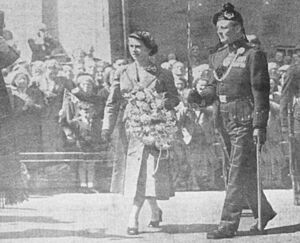
How Lanark is Governed
The people of Lanark are part of different voting areas, called constituencies.
Local Government in Lanark
For local elections, Lanark is part of the Clydesdale North ward. This ward chooses three people to represent them on the South Lanarkshire Council. This council makes decisions about local services like schools and roads.
Scottish and UK Parliaments
For elections to the Scottish Parliament, Lanark is part of the Clydesdale constituency. The people here also help elect seven extra members for the South of Scotland region. The current representative for Clydesdale is Aileen Campbell.
For elections to the UK Parliament in Westminster, Lanark is part of the Lanark and Hamilton East constituency. The current Member of Parliament (MP) for this area is Angela Crawley.
Famous Landmarks in Lanark
Lanark has 14 historic closes or vennels. These are narrow alleyways that lead to the High Street. Some are named after old shop owners. One is called Wallace Close because it shows important moments from William Wallace's life in Lanark.
Nearby Attractions and Nature
Visitors to Lanark can explore the nearby World Heritage Site of New Lanark. This historic village is close to the beautiful Falls of Clyde waterfalls. You can also visit the Corehouse estate and the Scottish Wildlife Trust's Corehouse Nature Reserve.
The Lanark Museum is located in West Port, inside the YMCA building. It's a great place to learn more about the town's history.
Lanark also has a large boating lake called Lanark Loch. Next to it is the Lanark Golf Club, which has an 18-hole course for experienced players and a 9-hole course. The old racecourse now offers pony-trekking activities.
The town's Castlebank Park is near where Lanark Castle used to stand. From here, you can reach the River Clyde and the Clyde Walkway, which is a path along the river.
Unique Town Features
An fancy gas lamp, known as the Provost's Lamp, stands at the bottom of the High Street. A provost was like a mayor of the town. After the town council was ended in 1975, the lamp was moved to a permanent spot near the Lanark Tolbooth.
One of the churches in town is called The Old Church of St Kentigern. St Kentigern, also known as St Mungo, set up many churches in Scotland long ago, including in Glasgow. He died around 612 AD. The town's cemetery is on the site of The Old Church of St Kentigern. It includes graves of many Covenanters, who were Scottish Presbyterians from the 17th century.
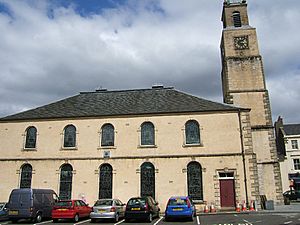
St. Nicholas Parish Church is at the bottom of the High Street. The church bell is thought to be from 1110, making it one of the oldest church bells in the world! It was moved from The Old Church of St Kentigern when St. Nicholas Church was built in 1774. An 8-foot (2.45 meter) statue of William Wallace stands in the church's steeple. This statue was made by Robert Forrest.
The Lanark Lanimers Festival
Lanark's rich history is celebrated each year with the Lanark Lanimers festival. This special event takes place for one week in June.
Lanimers Traditions and Events
- Choosing the Court: Local primary school children choose a Lanimer Queen and her court. A Lord Cornet is also chosen from local business people.
- Perambulation of the Marches: On Monday night, townspeople walk around half of the town's boundary. They follow the Lord Cornets (past and present) as they check the border-stones. People traditionally carry "birks," which are small branches from birch trees.
- Riding of the Marches: On Wednesday night, the other half of the boundary is checked. The Lord Cornet leads this, joined by many local riders on horseback. This is often called the "Rideout."
- Parade and Crowning: On Thursday morning, schools and other groups parade in themed costumes, with pipe bands. The best "Lanimer Lorries" (decorated floats) win prizes. After the parade, the Lanimer Queen is crowned on a special stand in front of St Nicholas' Church, under the statue of William Wallace.
- Reception Party: On Friday night, the Queen hosts a reception party in the town's Memorial Hall. Children perform songs and dances at this event.
Famous People from Lanark
William Wallace is one of the most famous people connected to Lanark. He was a key leader in the Scottish Wars of Independence. It is said that he first "drew his sword to free his native land" in Lanark in 1297. He killed the English sheriff Haselrig here. An 8-foot statue of Wallace, made by Robert Forrest, stands on St Nicholas Church.
Other notable people from Lanark include:
- William Smellie (1697–1763), a famous doctor who specialized in childbirth.
- Robert McQueen, Lord Braxfield (1722–1799), a senior Scottish judge.
- Colin McRae (1968–2007), a famous rally car driver. He was the British Rally Champion in 1991 and 1992, and the World Rally Champion in 1995. His father, Jimmy McRae, was also a rally champion, and his brother, Alister McRae, was also a rally driver.
Gallery
See also
 In Spanish: Lanark para niños
In Spanish: Lanark para niños


